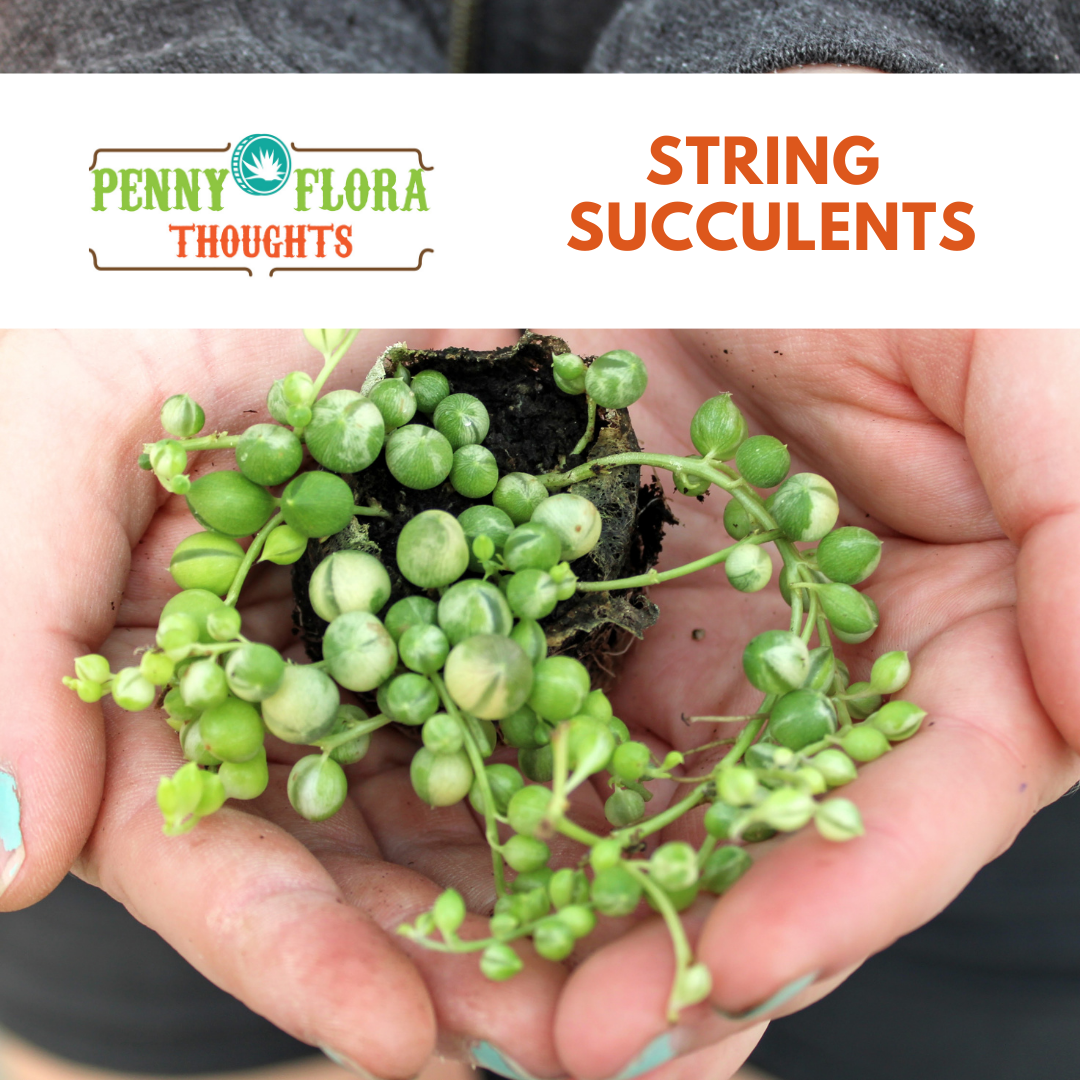String succulents are so adorable! Our Groovy Plants team loves their quirky leaf shapes from cascading strands of pearls and chains of jumping dolphins to wiry vines of hearts and turtles. They’re such irresistible houseplants and we love to display them in hanging planters or let them spill from a pot on a shelf or windowsill! In this post, we share how to turn a two-inch pot of string succulents into an epic container of living tresses. Some string succulents are related and others are totally different, so each requires unique care. But, don’t worry . . . we won’t leave you hanging on a string. Read on for more tips on these relatively easy-care plants.

General Care
Like all succulents, string succulents grow best in bright light and need to dry out between waterings. We caution you just to not totally abandon them like cacti.
To begin, transplant your new plants from their plastic containers into a similar size pot with a drainage hole. We prefer terra cotta pots for succulents, since they dry out faster. Start by filling the pot’s bottom with a cacti soil mix then insert your plant. Gently lift the strings and leaves and add more soil around the root ball until the pot is full. Next, thoroughly water the plant until water drains from the hole. Place your plant near a window with bright filtered light. Water again only when the soil fully dries out. Check the soil moisture by inserting a finger an inch into the soil. Wrinkling leaves are another sign that plants need watered. You’ll find many string succulents grow small insignificant flowers and we typically clip them off for a tidier look.
Depending on the string succulent variety, you may need to experiment with lighting and watering. Closely observe your plant when you make a change (like moving from a west window to a southeast one) and see how it responds. Repot string succulents every couple years with fresh soil. Just remember to go slow as you repot and be gentle with the plant’s fragile stems. Occasionally, string succulents will experience a case of mealy bugs. To treat, check out our post on Conquering Houseplant Pests.
To enhance a plant’s shape, try rotating its position in the sunlight and move vines around to even out the fullness. Also, the vines can be trimmed and cuttings can be placed atop new soil to make more plants or fill in the existing pot. With patience, the trailing vines will fully drape a container in two years or so.
String Succulent Favorites
String of Pearls (Senecio rowleyanus) – Native to drier parts of southern Africa, these beaded vines are found in that habitat creeping along the ground in rocky outcroppings. Their specialized, spherical leaves minimize their exposure to external weather extremes and conserve resources internally. The leaves even feature a cool adaptation for lower light – a leaf window -- that allows sun to enter each leaf’s interior.

String of pearls prefers diffuse medium to low-light. If the plant becomes pale and spindly, try a sunnier location. If the plant is dark and shriveled, then back off from the light. Also, string of pearls prefers more water than other succulents since it’s rounded leaves can’t store as much water. Our best advice is to water when the soil is completely dry, then fully drench soil until water comes out the bottom.
Sometimes, string of pearls can look sparse on top, especially when the plant doesn’t receive enough sunlight. Don’t sweat! Simply take a couple strands and lay them on the top of the soil. Use a couple garden pins to hold them in place until they take root. Also, make sure the entire pot is receiving enough light to keep the top looking its best.

String of Watermelons (Senecio herreanus) -- Trailing stems are lined with oval, pointed, bead-like leaves with watermelon striping. Like String of Pearls, this string succulent features translucent “leaf windows” to help the plant absorb more sunlight.

String of Tears (Senecio herreanus) – This string succulent can handle less light than a typical succulent and over a few months of growth, if properly cared for, this plant can look like a cascade of little green pearls spilling out of a planter. It can be a tricky plant to take care of indoors, but it is totally worth the effort! They need bright sunlight, great drainage, and infrequent water to prevent rot.

String of Fish Hooks (Senecio radicans ‘Fish Hooks’) – This vining succulent looks very similar to String of Bananas but features somewhat blue and hook-like foliage. It is a fast grower and native to South Africa. Place near a sunny south-facing window and thoroughly water when dry.

String of Dolphins (Senecio peregrinus) – The chalky blue leaves on this rare string succulent grow in an arch, each with two small attached “fins,” making the vines look like a pod of playful porpoises. They need plenty of sun, ideally near a south-facing window. Over time, this plant will grow large and makes quite a show in a hanging basket. For growing details, see Jared’s String of Dolphins tutorial.

String of Hearts (Ceropegia woodii) -- This beauty is aptly named with its charming heart-shaped variegated leaves dangling on wire-like stems! It is fast growing, hanging succulent. It's certainly one of our favorites! It's perfectly happy in less than full sun and will reward good care with cute pink trumpet flowers in the fall.

String of Needles (Ceropegia linearis subsp. debilis) – This string succulent is easy to care for and features very thin leaves on the characteristic long stems. Since they are epiphytes by nature, they need a well-draining soil, like a cactus mix enhanced with gravel, coarse perlite or pumice. These plants also prefer more humidity than other drought tolerant succulents. Bright indirect light works best for them.

String of Turtles (Peperomis prostrata) -- The leaves on String of Turtles grow in a circular shape that have a colorful pattern similar to a tortoise shell. They also have a surprise splash of color—while most string succulent vines are green, these grow on a vine of reddish brown, making those “shells” really stand-out. Place in medium indirect light and water sparingly.

String of Coins (Dischidia nummularia) This rare plant and the priciest of the list features vining stems laden with smooth green leaves. This plant is incredibly easy to grow and will add the most intriguing look to your collection! Just place in medium to bright light, and water when the soil surface starts to dry.



2 comments
I want this! I’m loving the contrast and color. It’s very striking.
I WANT THEMS